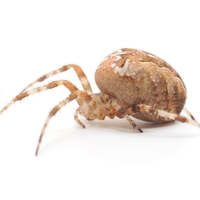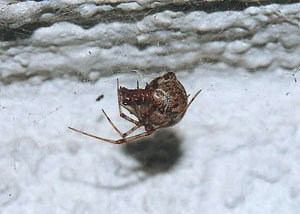How to Identify House Spiders
Spiders instill fear in many people. Spiders are non-insect arthropods. They have 2 body parts and 8 legs. Insects have 6 legs. Spiders are hunters of insects and other arthropods that are caught in their webs. A house spider is the most common spider found in or around every structure. A female house spider is 3/16 to 3/8 inches in length. Color can vary – molted colors are yellowish brown to dirty gray with some dark spots. Males are a bit smaller. All spiders produce silk threads which are used for the web, egg sacs, to catch prey, hold prey, to make protective areas and/or ballooning also known as dynamic kiting. This silk hardens upon contact with the air. Spiders are master weavers. Here is an interesting fact: a thread of spider silk long enough to go around the world would weigh 16 ounces.
 The Biology of House Spiders
The Biology of House Spiders

The female house spider produces a sac which holds its eggs. This sac contains up to 250 eggs. A female can lay up to 17 sacs in her lifetime, producing more than 3,700 total eggs. A web can contain 2 sacs but usually, there is only one sac placed in the middle of the web.
The eggs hatch in the sac. If you look closely you can sometimes see the spiderlings on the web. After the second molt, spiderlings have the ability to produce silk strands that enable them to catch air currents and float with the wind to their new home. This is known as “ballooning” and also known as “dynamic kiting.” This silk hardens upon contact with the air.
Where do you See House Spiders?
- You can see this pest or its evidence throughout the house or structure, inside and out. This is especially true in wooded lots.
- The house spider builds its nest under almost anything – coffee tables, end tables, dressers, beds, cabinets, in low corners and high corners.
- If you see a cobweb, it was built by a spider.
- This web can be seen in all locations of the home – inside, outside, crawlspaces, basements, attics, garages, and storage areas.
- If a location does not have enough food sources, the spider will abandon the web and move to a more suitable location; thus the cobwebs.
Feeding Preferences of House Spiders
Spiders feed on live insects, mites, and other arthropods. The food source is typically alive and the spider injects its prey with venom. Spiders can only ingest liquid as a food source. Some spiders use webs to catch prey. Others are active hunters, and still, others are passive hunters waiting for prey.
Ways to reduce the conditions that harbor and attract house spiders:
- Repair or install tight-fitting screens on windows, doors, gables, foundation and soffit vents
- Install weather stripping and door sweeps
- Seal gaps around doors and windows
- Repair foundation cracks
- Seal around HVAC systems
- Install yellow or sodium lights since these attract fewer insects, which are the spiders’ food source
- Seal stored items in tight-fitting plastic containers in basements, garages and storage units
- Seek professional assistance and a pest prevention plan
Ways to reduce spider bites:
- Inspect clothing and shoes before getting dressed
- Remove all spider webs, especially under beds, nightstands and in clothes closets
- Move beds away from walls
- Use gloves when moving stored items, working in the garden, moving firewood, etc.
- Store items off the floor
- Remove or discard unwanted items
- Move firewood away from home
Economy Exterminators’ Pest Control Solutions program uses the 4-step approach to solve your house spider pest problem:
- Our 1st step is the inspection of the property by a Raleigh, Charlotte or Wilmington customer service specialist. It is very important to know the species involved and the severity of the pest problem.
- The 2nd step is the initial treatment by a customer service specialist of all areas that the inspection revealed as critical areas. Economy Exterminators uses the newest and most effective materials to solve this pest problem quickly for you. Usually, critical areas include the inside the structure, storage areas, crawlspaces, attics, and garages. Our Pest Control Solutions program includes the treatment of these spiders but also the sweeping down and the removal of these spider webs on the inside and outside of the home. This helps to reduce the next generation of spiders since the removal of webs will remove the eggs sacs as well. Your inspector and/or technician will be able to advise you on any additional treatments necessary at no additional charge. On the building exterior, special attention will be applied to all the windows, doors, eaves and the foundations. Special time and effort will be spent locating these spiders and webs.
- The 3rd step is a 37-point inspection of your property to identify areas that give house spiders easy access by either direct access or cracks in the foundation.
- The 4th step is an ongoing maintenance program for the next generation. New infestations will be moving onto your property by ballooning from your trees or from the adjoining property. Our exclusive pest control program is designed to help prevent the next generation. And as always, our unlimited extra service is at no charge.

 The Biology of House Spiders
The Biology of House Spiders


